Affiliate links on Android Authority may earn us a commission. Learn more.
Snapdragon 810 vs 805: what to expect from Qualcomm's next high-end SoC
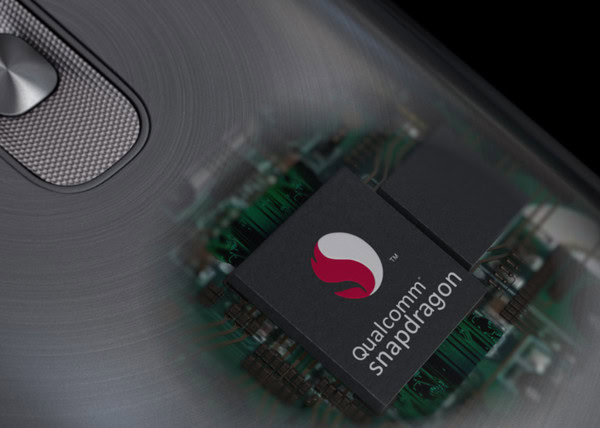
Qualcomm’s new Snapdragon 810 is already powering LG’s high-end G Flex 2 and will be the brains behind many a flagship smartphone this coming year. The Snapdragon 805 already sets a rather high benchmark for performance and features, so let’s examine how Qualcomm intends to improve its popular 800 series of mobile processors as it moves into the 64-bit generation.
Processing Power
| Snapdragon 810 | Snapdragon 805 | Snapdragon 801 | |
|---|---|---|---|
Cores | Snapdragon 810 8 | Snapdragon 805 4 | Snapdragon 801 4 |
CPU | Snapdragon 810 4x Cortex-A57 + 4x Cortex-A53 | Snapdragon 805 Krait 450 | Snapdragon 801 Krait 400 |
Arch | Snapdragon 810 ARMv8-A (32 / 64-bit) | Snapdragon 805 ARMv7-A (32-bit) | Snapdragon 801 ARMv7-A (32-bit) |
GPU | Snapdragon 810 Adreno 430 | Snapdragon 805 Adreno 420 | Snapdragon 801 Adreno 330 |
Memory | Snapdragon 810 LPDDR4 1600MHz 64-bit | Snapdragon 805 LPDDR3 800MHz 64-bit | Snapdragon 801 LPDDR3 933MHz 32-bit |
DSP | Snapdragon 810 Hexagon V56 | Snapdragon 805 Hexagon V50 | Snapdragon 801 Hexagon V50 |
Process | Snapdragon 810 20nm | Snapdragon 805 28nm | Snapdragon 801 28nm |
The Snapdragon 810 marks the first 800 series chip to depart from Qualcomm’s customized Krait CPU core design and is also the first Qualcomm mobile SoC to reach 20nm. The reasons for the change in CPU cores is that Qualcomm is making the move over to the latest 64-bit ARMv8 architecture, which requires a new CPU design.
The customized 32-bit Krait 450 quad-core makes way for two sets of 64-bit quad-core chips. Four high-performance ARM Cortex-A57s nestle alongside four low-power ARM Cortex-A53s, arranged in a reference big.LITTLE configuration, similar to Samsung big.LITTLE Exynos line-up. Unlike early Samsung chips, all eight cores in the Snapdragon 810 can be active at once, as the chip makes use of Global Task Scheduling.
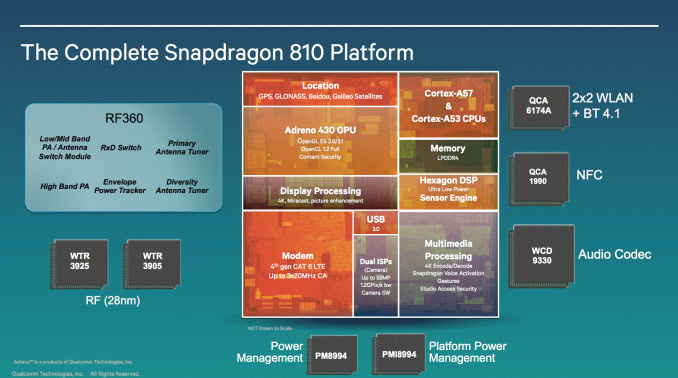
The Cortex-A57 offers around a 20 to 50 percent boost over the older Cotex-A15 design that Qualcomm’s Krait CPU cores are based on, depending on the scenario. However, this comes at the expense of 20 percent more power consumption. Fortunately, the Cortex-A53 is a more efficient replacement for the low-power Cortex-A7, which, combined with the smaller 20nm manufacturing process, should help offset the battery sapping A57 cores. By efficiently managing workloads across all eight cores, the octa-core big.LITTLE design should result in a higher level of peak performance when needed but a lower level of background and idle power consumption.
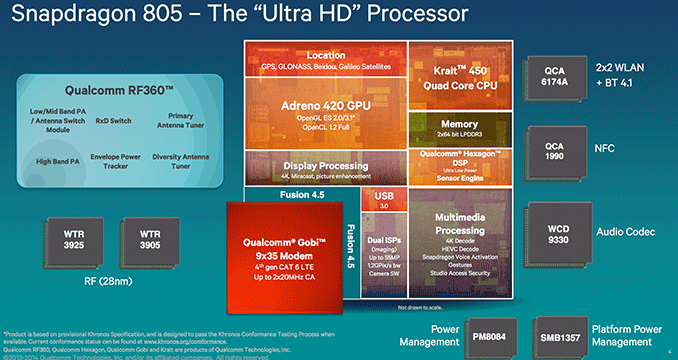
When we compared the Snapdragon 805 to the slightly older 801 we were mostly looking at improvements to Qualcomm’s Adreno GPU technology. This time around, the CPU is the biggest change between generations, as the Adreno GPU is simply swapped out from an Adreno 420 in the Snapdragon 805 to a 430 in the 810. That being said, the Adreno 430 supposedly boosts performance by up to 30 percent compared with the Adreno 420, making it around 80 percent faster than the last generation Adreno 330. With gaming on Android becoming a bigger deal each year, the Snapdragon 810 will make sure that frame rate is not an issue.
Performance is expected to improve across the board between the Snapdragon 810 and 805. The new CPU designed should finally see some general performance gains compared to the tried and tested Krait cores in the 32-bit 800 series and the new high-end Adreno GPU should offer a top of the line experience for video content consumers and gamers.
SoC Features
As well as increasing the raw processing power of its latest Snapdragon, Qualcomm has also implemented improved LPDDR4 memory support and a faster Hexagon V56 DSP chip in the 810. The fast 3200MHz RAM data rate and 25.6GB/s memory bandwidth should see applications open and transition that bit smoother on the 810 and the improved DSP chip will help further offset the CPU load for music and high-quality video processing.
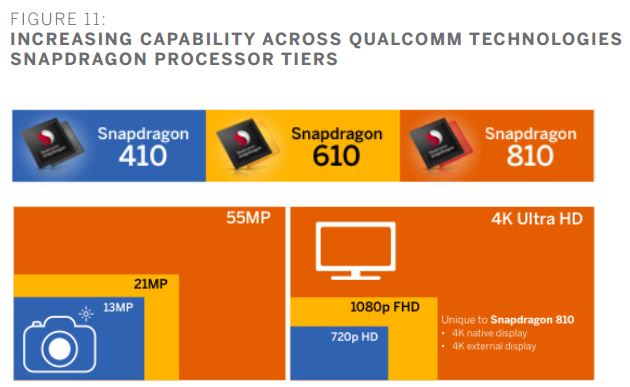
The Snapdragon 810’s ISP has received a modest improvement, moving up to a 14-bit dual-ISP design with a 1.2GPixels/s throughput, improving performance by around 20 percent compared with the 805. NFC, 802.11n/ac WiFi, GPS, and Bluetooth 4.1 support is also identical between the two. Quick Charge 2.0 technology is also supported, with a current draw of up to 3A.
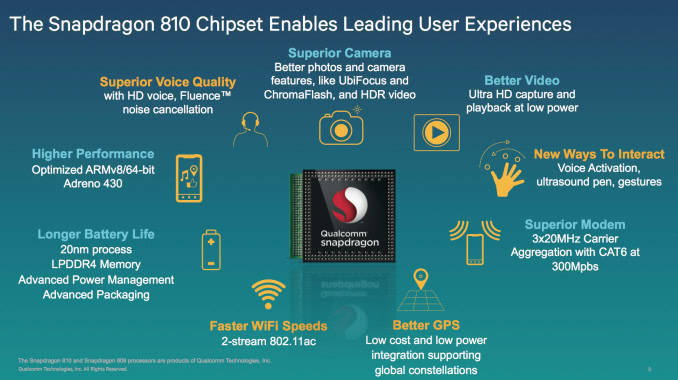
When it comes to displays, both SoCs are suitable for use with up to 4K on-device and can support 1080p and 4K external displays as well. Qualcomm has also been eager to tout its improved LTE data speeds, with both chipsets supporting CAT6 speeds of up to 300 Mbps. Although the 810 now support up to 3×20 MHz carrier aggregation, up from 2x. The modem supports LTE FDD, LTE TDD, WCDMA (DC-HSPA+, DC-HSUPA), CDMA1x, EV-DO Rev. B, TD-SCDMA and GSM/EDGE networks.
What does it mean for me?
Enough of the tech terms, the really important issue is what Qualcomm’s latest chip brings to the consumer experience.
Performance wise, we should expect a modest step up from the Snapdragon 805 and gamers will definitely want to make use of the newer Adreno 430. General app/CPU performance will look something like the Exynos 5433 Galaxy Note 4, which features an octo-core Cortex-A57 and A53 set-up. Battery life is still an issue these days and a big.LITTLE Qualcomm chip should be able to squeeze out a few more hours of life when performing simple tasks. However, battery life when gaming or running more intensive apps is unlikely to change much, as the 20nm energy efficiency gains will likely be offset by increased performance.
Feature wise, those in areas with a fast 4G/LTE network won’t see much of a data speed boost between the Snapdragon 805 and 810, as they both top out at 300Mbps. Average speeds and connection quality may improve in a few areas, as the Snapdragon 810’s modem can connect to three bands at once, rather than two. Phones powered by either SoCs will suite those looking to playback or record high resolution video and image content, as ISP, DSP, camera, and display features and support are virtually identical between the two.
The final major difference between the 810 and 805 comes from the CPU architecture. The Snapdragon 810 is a 64-bit chip, while the 805 is only 32-bit compatible. At the moment, this doesn’t make any major practical difference because 64-bit applications are not widespread. However, as Android Lollipop continues to roll-out and more 64-bit capable smartphones hit the market, the Snapdragon 810 may benefit from slight performance improvements down the line, at least when running certain applications. That said, this might be worth considering if you want the most future-proof smartphone right now.
The Snapdragon 805 was clearly a feature stepping stone between the 64-bit Snapdragon 810 and the Snapdragon 801 found in many of last year’s flagships. We may have seen some features of the 810 already, but the performance gains and more efficient 20nm manufacturing node are the real talking points anyway. Qualcomm’s latest SoC certainly seems to have the performance and features demanded by today’s smartphones and tablets.